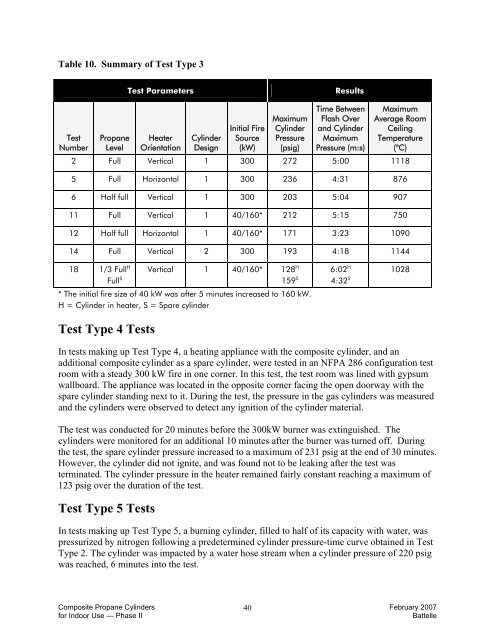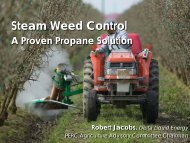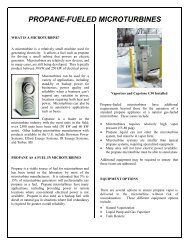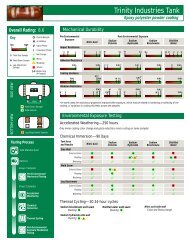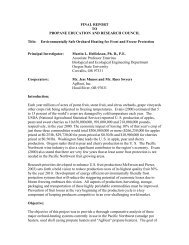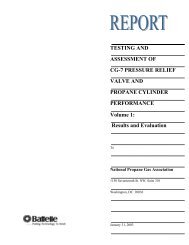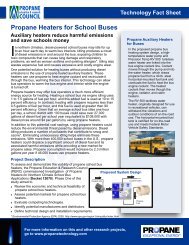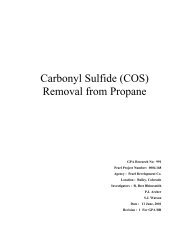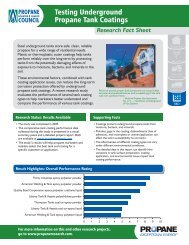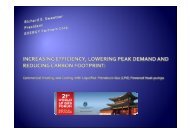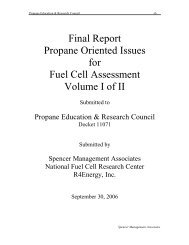Code Approval of Composite Propane Cylinders for Indoor Use ...
Code Approval of Composite Propane Cylinders for Indoor Use ...
Code Approval of Composite Propane Cylinders for Indoor Use ...
You also want an ePaper? Increase the reach of your titles
YUMPU automatically turns print PDFs into web optimized ePapers that Google loves.
Table 10. Summary <strong>of</strong> Test Type 3Test ParametersResultsTestNumber<strong>Propane</strong>LevelHeaterOrientationCylinderDesignInitial FireSource(kW)MaximumCylinderPressure(psig)Time BetweenFlash Overand CylinderMaximumPressure (m:s)MaximumAverage RoomCeilingTemperature(°C)2 Full Vertical 1 300 272 5:00 11185 Full Horizontal 1 300 236 4:31 8766 Half full Vertical 1 300 203 5:04 90711 Full Vertical 1 40/160* 212 5:15 75012 Half full Horizontal 1 40/160* 171 3:23 109014 Full Vertical 2 300 193 4:18 114418 1/3 Full H Vertical 1 40/160* 128 H 6:02 H 1028Full S 159 S 4:32 S* The initial fire size <strong>of</strong> 40 kW was after 5 minutes increased to 160 kW.H = Cylinder in heater, S = Spare cylinderTest Type 4 TestsIn tests making up Test Type 4, a heating appliance with the composite cylinder, and anadditional composite cylinder as a spare cylinder, were tested in an NFPA 286 configuration testroom with a steady 300 kW fire in one corner. In this test, the test room was lined with gypsumwallboard. The appliance was located in the opposite corner facing the open doorway with thespare cylinder standing next to it. During the test, the pressure in the gas cylinders was measuredand the cylinders were observed to detect any ignition <strong>of</strong> the cylinder material.The test was conducted <strong>for</strong> 20 minutes be<strong>for</strong>e the 300kW burner was extinguished. Thecylinders were monitored <strong>for</strong> an additional 10 minutes after the burner was turned <strong>of</strong>f. Duringthe test, the spare cylinder pressure increased to a maximum <strong>of</strong> 231 psig at the end <strong>of</strong> 30 minutes.However, the cylinder did not ignite, and was found not to be leaking after the test wasterminated. The cylinder pressure in the heater remained fairly constant reaching a maximum <strong>of</strong>123 psig over the duration <strong>of</strong> the test.Test Type 5 TestsIn tests making up Test Type 5, a burning cylinder, filled to half <strong>of</strong> its capacity with water, waspressurized by nitrogen following a predetermined cylinder pressure-time curve obtained in TestType 2. The cylinder was impacted by a water hose stream when a cylinder pressure <strong>of</strong> 220 psigwas reached, 6 minutes into the test.<strong>Composite</strong> <strong>Propane</strong> <strong>Cylinders</strong> 40February 2007<strong>for</strong> <strong>Indoor</strong> <strong>Use</strong> — Phase IIBattelle


